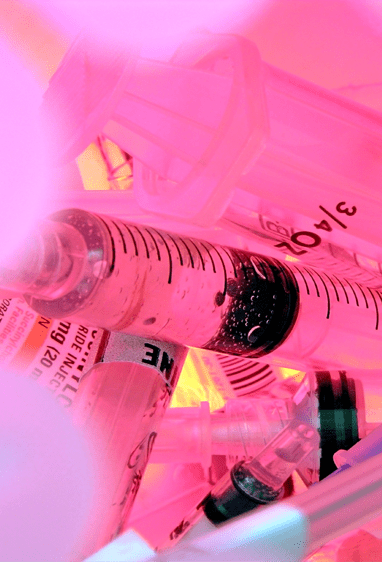100,000 sharps injuries occur within NHS hospitals each year, and are a well-known safety risk in the health and social care sector, which puts many people’s health under threat. Sharps can transmit more than 20 diseases when contaminated with an infected patient’s blood. However, the use of sharps cannot be avoided in certain industries such as healthcare, tattooing and body piercing, beauty and chiropody, which is why relevant precautionary measures must be taken when dealing with such instruments.
Table of Contents
What is a sharps injury?
A sharps injury is an incident that causes medical instruments required for performing healthcare work to penetrate the skin. This involves equipment such as needles, blades and scalpels. It is sometimes called a percutaneous injury.
What is the risk?
As with most injuries, the main risk is the effect of the injury itself on the body, however, with sharps incidents, the injury itself is not the main issue, the biggest risk is the potential for exposure to and transmission of infectious diseases or blood-borne viruses (BBV). This can occur when a healthcare worker sustains an injury from a sharp that is contaminated with blood or bodily fluid from a patient. The BBV’s which cause the most serious concerns are:
- Hepatitis B (HBV)
- Hepatitis C (HCV)
- Human Immunodeficiency Virus (HIV)
The transmission of these infections can depend upon a number of factors combined with the state of the person’s natural immune system. The effects of these injuries and the concern involved about the potential consequences can have a substantially harmful personal impact on the injured individual, along with the adverse side effects of post-exposure prophylaxis.
The highest risk is when the syringe is not being used or is being disposed of and the needle is exposed.
Who is at risk?
All workers involved in health and social care. Those who directly handle sharps, and those who don’t. Individuals can be inadvertently put at risk if sharps aren’t stored or disposed of correctly.
Victims of sharps injuries are at higher risk of infection if the injury happens during procedures such as intra-vascular cannulation, venipuncture, injections and the use of IV cannulae, with medical instruments such as hollow-bore needles, winged steel-butterfly needles, syringes and phlebotomy needles.
What to do if you obtain a sharps injury
If you or someone you know has sustained an injury from a potentially contaminated sharp you should follow these procedures:
- Encourage the wound to bleed gently, while holding it under running water
- Clean the wound using running water and soap
- Do not scrub the wound whilst washing
- Do not suck the wound
- Dry the wound and cover it with a waterproof dressing or plaster
- Seek urgent medical advice, because effective prophylaxis (medicines that fight infections) are available
- Report the injury to your employer
How to prevent sharps injuries
Due to the high risk associated with sharps injuries and the emotional anxiety that is caused for those who receive them, healthcare establishments have a legal obligation to implement regulations designed to protect them, these include:
- The Health and Safety at Work Act 1974
- The Control of Substances Hazardous to Health Regulation (COSHH) 2002
- The Management of Health and Safety Regulations 1999
- The Reporting of Injuries, Diseases, and Dangerous Occurrences Regulations 1995 (RIDDOR)
In addition to the above, the Health and Safety (Sharp Instruments in Healthcare) Regulations 2013 introduced the EU Council Directive on 10th May 2010. This surrounds the prevention of sharps injuries in the hospital and healthcare sector, which applies to all workers.
This states that employers must provide a risk assessment and sufficient training to employees on the elimination, prevention and protection from sharps and what to do if they obtain a sharps injury, in addition to providing information about the risk of medical sharps injuries, the legislative requirements imposed for their protection, how to undertake good practice in preventing injury, the benefits and draw-backs of vaccination and non-vaccination from blood-borne diseases and the support legally required from the employer to them if they are injured by a medical sharp at work.
Effective management and disposal products are available to help minimise the risk of needle-stick injuries.
Here you can find more information on the EU Council Directive for the prevention of sharp injuries and the official legislation.
